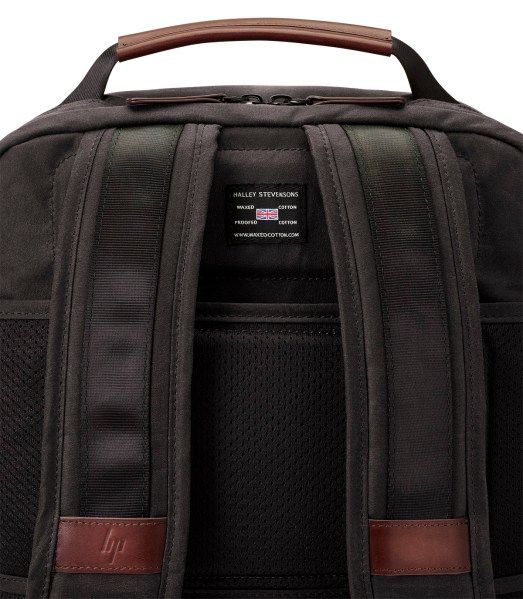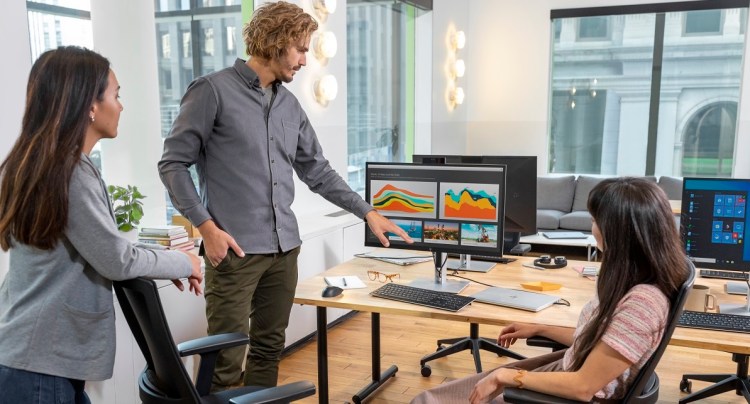VentureBeat: I was going to borrow a laptop, and one of my missions is to see if it can last through press day at CES. It made me think. For me, because that’s a peak day of the whole year, I need to get a laptop with enough battery life to get all the way through. Is that an example of the way people are buying their machines? They have a peak usage in mind and they have to gear everything they prioritize in the machine toward that peak usage.
Cho: We find that there are a lot of different types of episodes that people have throughout the day. We see different — not only personas, but these episodes where people are, say for work, transitioning from heavy content creation to consumption. Creation might be something as simple as email response, or creating analyses and presentations and proposals. Consumption might be getting through a lot of email or doing training online. More than 50% of collaboration, in most cases, is employees connecting with colleagues or customers on other sites. We see them transitioning through those things on the device.
That’s what we use as use cases for things like our Dragonfly products, our commercial notebook. We recognize they have a high need for performance, number one. It’s a full commercial device. Mobility, they’re moving around to different places. It’s the world’s first with — we have 4X4 LTE antennas, as well as Wi-Fi 6 that they introduced, making sure they’re connected and rapidly transferring data wherever they are.

Above: The HP Elite Dragonfly G2 is the world’s lightest compact business convertible laptop, HP says.
VentureBeat: I have to do a lot of video transfer on those days. It feels like that’s another big demand.
June 5th: The AI Audit in NYC
Join us next week in NYC to engage with top executive leaders, delving into strategies for auditing AI models to ensure fairness, optimal performance, and ethical compliance across diverse organizations. Secure your attendance for this exclusive invite-only event.
Cho: Right. People used to think that video was only for creative professionals, but we’re seeing use cases — people in all forms of work are accessing video-related content. Also, it’s all around collaboration, as I mentioned. We look at those use cases and design. That’s why we’re very excited about our Elite products, our Elite Dragonfly. It really pushes productivity, mobility, and security through the types of things people are doing throughout the day.
VentureBeat: I like the big displays. I thought the one feature that might make a difference if people were thinking of using the all-in-one or the big display for gaming is they’d want it at 120Hz instead of the 60Hz. Have you thought about this notion that you could have that product for all markets, for the gamers as well as the professionals and creators, if you changed that one feature? I don’t know if there’s more that gamers would demand on top of that, but I generally see the folks who are touting displays for gamers delivering them at 120Hz or 240Hz. Putting one out there at 60Hz seems like it might miss that part of the market.
Cho: We’re very much covering all the different use cases around displays, including 240Hz refresh rates. You’re absolutely right. If you look at our higher-end displays, we span that, but we also span down to where people are prioritizing other elements of the price-value stack. That’s why we have a continuum of refresh.
Obviously we have a continuum of sizes as well. For those who are looking for effectively two 24″ displays side by side, we announced our 43″ curved display. That includes our device bridge. Not only can you, from one PC, tile two windows side by side to maximize productivity, but you can also plug in two different devices simultaneously with a single keyboard and mouse and manage across both. That gives you another type of use case enablement.
Especially for these work environments — touchdown stations are such a big part of the experience. They may not be sitting down all the time, but when they sit down they want to be immediately and quickly productive. These docking displays that are fully manageable, so IT feel like they can manage it — it’s a corporate resource — that’s also part of what we’re offering.
As you know, we have it tuned for office environments, for gaming environments, and for workstation environments, our Z display, where we’re prioritizing DreamColor and higher use cases that are very tied to creative workloads. We’re very much enabling that across the portfolio.
VentureBeat: There isn’t a specific line of gaming products being announced at CES, but does gaming remain a big priority for you?
Cho: Oh, yes. We love gaming. You know we love gaming. It continues to grow. What’s interesting, gaming is something — there are more and more segments participating. Not only is the core gaming segment growing, but as well, women are now 40% of the market. Seventy percent of the market is over 18. You have multiple segmentations around people who are enthusiasts or casual.
Our plan is to continue to innovate. It’s not just a hardware play, too. It’s around building the ecosystem experience. We have fantastic innovation around our core products. We announced the world’s first dual-screen gaming laptop, for example. Then really curated displays and accessories around this, whether it’s a zero-latency wireless mouse or displays operating at 240Hz. Very much adding to or completing the immersiveness of experience, and branded together for the overall portfolio.
Third is the services and software around it. We took Omen Command Center, our online platform by which you can configure your accessories and products, and earlier we introduced AI coaching for League of Legends. We also announced a rewards program here in the U.S. Across the products, accessories, displays, services, AI, it’s very holistic. It’s an attractive segment, because there’s so much innovation and so much interest. It’s a wide demographic. People’s experience with us is such an important part of the overall compute portfolio we offer.
We don’t have new gaming product announcements at CES because we have a lot that we’re planning this year. We’re trying to space it out, especially tied to some gaming-focused venues later in the year. But we have a lot coming. It’s cool. It’s super cool and exciting.
VentureBeat: Last year at this time we probably both thought we’d hear more about 5G in 2019. Now it feels like we’ll wait a bit more into the next year for 5G use cases to come to life.
Cho: I feel as though — if you look at this year, at least from our side, we did a lot around enabling better connectivity. Let’s talk about 4X4. It’s very important, so that LTE gets materially faster. That’s available today, and that’s something that the end user will experience all the way through, because infrastructure is available to them all the way through from the device to the provider. Even Wi-Fi 6, that’s very material. This isn’t stuff that doesn’t get materialized end to end. The end customer experiences the benefits of that. We introduced that, and we’re the world’s first across consumer and commercial device innovations for this year.
In the whole area of connectivity, we’re very bullish on staying at the meaningful leading edge on this. You see it across our portfolio. We did a lot, and it’s been a very important part of our Net Promoter Score. Net Promoter Score is a religion for us, and connectivity that users see in what they experience and what they do is important.
We’re announcing, at CES, on our commercial platform, 5G enablement. As the market gets more mature and ready, really enabling it, we’ll do that across the broader portfolio. Connectivity is something that we have a lot of passion on. We think it improves the experience. Because of that, you see a lot of energy around it. We did it in many practical, tangible, and leading ways in FY2019.

Above: HP Spectre Folio Backpack
VentureBeat: On the experimental side, how are you looking at some of those products? I think of things like the Sprout style of computers, taking advantage of 3D capture or 3D printing.
Cho: We announced, at Adobe Max, our broader vision around what we call capture, create, and experience. By that we mean we’re formalizing this ecosystem — tied to my earlier point around growing creative use cases on the PC, we believe there are some rich growth opportunities.
When I say capture, create, and experience, on capture — this is all around taking the physical world and digitizing it. We announced a project together with Adobe that we call Project Captis. We’re able to capture 3D textures and help build libraries for the digital space. In the create space we have a rich portfolio of Z workstations tuned for creative workflows, whether it’s 2D and 3D, and helping to enable better creation. If you think of the offramps, what we call experience, whether it’s around 2D print, 3D print, displays, commercial VR, we’re continuing to offer the widest set of offramps on that.
We announced, first, that we’re formalizing continuing to take that end-to-end ecosystem from capture to create to experience even further. We’re partnering on key elements of it with partners, Adobe being a key one we announced. We’re continuing to take that to the next level. We announced Project Captis around the capture area. We’ve refreshed and we’re continuing to build around our create solutions in computing. We have a lot around the offramp touch points. You’ll see a lot more around that as we go forward.
VentureBeat: AMD had a historic year for its Ryzen processors. I wondered how that looks to you as far as how competitive the microprocessor battle is these days.
Cho: It’s been difficult, because we’ve been constrained to our demand. We’ve been working very closely with Intel, working through that, as well as our customers and our channel partners. At the same time, we have a very broad AMD portfolio. The AMD portfolio gives customers choice. Their Ryzen portfolio has really improved. Yes, we are constrained, and yes, we are working with Intel and our partners, but also yes, we are leveraging a broader portfolio for our customers with additional products. It’s a good option for them.
VentureBeat: What can you say on the sustainability side of things?
Cho: This is something that’s so important — it’s important to me personally. It’s not new. We’ve been working at it. We’re increasingly improving our ability to make our sustainability impact. It’s very tangible. We’ve made milestones. The world’s first ocean-bound plastic display, the world’s first ocean-bound plastics in our notebooks. We’re continuing to grow into recycled materials. We’re using CDs and DVDs for our Dragonfly keycaps. We’re focused on education, enabling learning outcomes.
We’ll get to you more around that, but you saw several of the CES announcements tied to that. I love working here because of this, to be honest. We’re doing things I personally feel are important and will contribute. We’re very excited about sharing more of that with you.


